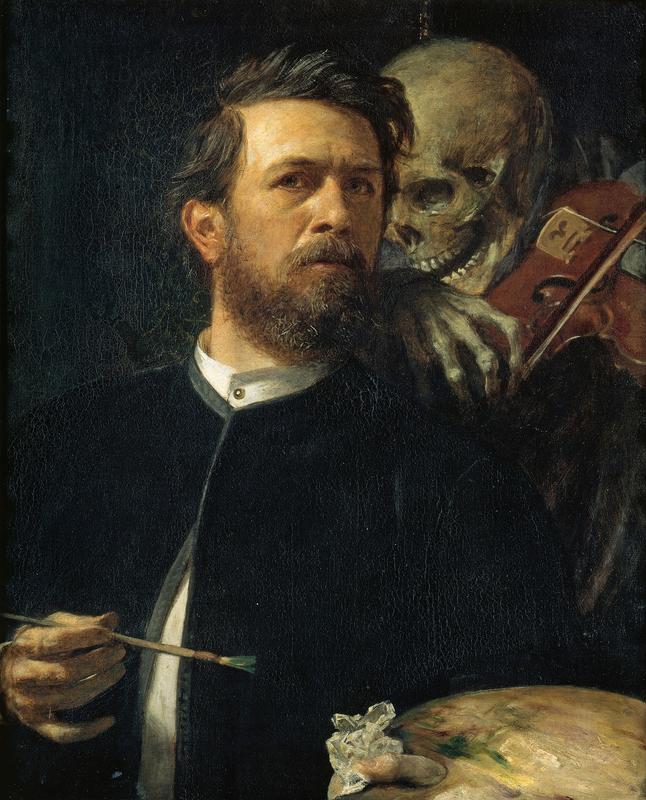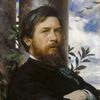More about Self-Portrait with Death Playing the Fiddle

Contributor
According to one account, the figure of Death looming over Arnold Böcklin’s shoulder (and presumably distracting him from his work by playing some screechy music on a one-stringed violin right in his ear—ouch!) was included in this self-portrait only as an afterthought.
Upon seeing the incomplete painting, the story goes, a friend asked Böcklin what he was listening to based on the far-off expression in his eyes and the slight tilt to his head. In response, he naturally added a skeletal reminder of his own mortality into the background, thus turning the painting into a contribution to the longstanding tradition of memento mori artworks which such macabre characters tend to populate. The single-stringed violin suggests that Böcklin’s time is running out; the others have presumably all snapped, and Böcklin is, it would appear, listening to the sound of his own death creeping closer to him as the music playing in his ear grows more frantic and dissonant with each broken string. It’s possible that this image of the final string is meant to be an allusion to the Fates of Greek mythology, who (as we all well know from Disney’s "Hercules") had the power to quickly kill mortals by cutting a thread representing their lifespan. And Böcklin was a huge nerd for Greek mythology, so this reading seems entirely plausible.
Böcklin’s choice to depict his skeletal companion playing a violin may also be a reference to a late medieval subgenre of the memento mori called the danse macabre (meaning, delightfully, the “dance of death”), which he would have been exposed to either in the woodcuts of Hans Holbein the Younger or painted on the walls of a cemetery in his hometown Basel, Switzerland, where some of the earliest examples of the theme could be spotted. The general message of the danse is that all people, regardless of their station in life, must eventually die. An uplifting message, I suppose, if your life isn’t all that great to begin with, and Böcklin’s was pretty rocky, to say the least, even if he didn't live during the time of the plague.
He certainly would have been well-acquainted with death by the time he painted this self-portrait, his first fiancée having died before they had a chance to get married, and his eventual wife giving birth to fourteen children, five of whom died in childhood. Perhaps the reason behind his old friend Death’s intimate proximity at his shoulder (and Böcklin being totally cool with this disregard for his personal space) is his constant awareness that they could meet at any moment. He doesn’t seem all that fazed by the idea, though. Instead, he casually leans back to hear what Death has to tell him, his gaze pensively directed away from the viewer as he listens carefully to its song, as if Death is for him a trusted confidante or advisor giving him some honest feedback on his work rather than something to be feared. Böcklin would draw upon this depicted familiarity with death again eight years later, in his iconic 1880 painting The Island of the Dead.
Böcklin creates an illusion of naturalness by having his painted double look away from the viewer, giving himself the appearance of having just paused for a moment in his work to listen to Death at his shoulder, evidently unaware that we can see him. What he’s painting, where he’s looking, and what precisely Death is whispering in his ear are all kept from us, reinforcing a voyeuristic position of the viewer and suggesting that this self-portrait wasn’t posed (although, of course, it was). And yet there’s something very self-conscious about including a memento mori in your own self-portrait. Böcklin may well have been poking fun at himself and the genre of self-portraiture at large in this choice; perhaps he had a real moment like this one when he paused in his work to consider why he felt the need to preserve his own image in paints and, laughing at his own foolishness, added in the figure of Death at last minute, a tongue-in-cheek answer to his own question. In a very modern and self-reflexive move, Böcklin seems to have used this opportunity to comment on the fear that lies, at least on some level, behind every self-portrait an artist creates—namely, that of Death sneaking up behind to sweep away the living body a portrait seeks to preserve.
In this way, the painting could also be read as a clever take on vanitas, another subgenre of memento mori meant to remind one of the transience of earthly pleasures, usually taking the form of a still life. But here Böcklin is playing on the double-meaning contained within the term; “vain” (derived from the Latin vanitas) can mean futile, valueless, or not worthy of pursuit, the sense in which it is usually meant in the vanitas still life. But if you’re vain, it can also mean that you have an overly-high opinion of yourself, and Böcklin, by painting his own image into some version of a vanitas still life, seems to be having a good hearty laugh at himself for being so big-headed that he would actually want to paint his own portrait. Such a comic approach was pretty on-brand for Böcklin. He was primarily known for his irreverent take on scenes from classical mythology, a sort of in-joke he had with himself which made him incredibly popular with 19th century European audiences, who by that point had gotten pretty tired of seeing the same scenes depicted in the same decorous way over and over again.
Although frequently labelled as a Symbolist and highly influential on the Surrealists of the following century (Max Ernst in particular), Böcklin largely preferred to march to his own beat. He spent a significant portion of his life living in Rome studying Renaissance and Baroque art, and as a result was more or less unaware of all the shiny new modern art movements that were unfolding during his lifetime. This at least partially explains all the memento mori symbolism, which was at its trendiest in the early 17th century. He may have been a little late to that particular party, but, as with all his reworkings of old themes, still managed to bring a dash of his signature Böcklin humor to it, making something completely new.
Sources
- “Arnold Böcklin.” The Art Story. Accessed March 24, 2020. https://www.theartstory.org/artist/ bocklin-arnold/artworks/.
- “Arnold Böcklin (1827-1901) A Modern Visionary.” Musée d’Orsay. Accessed March 26, 2020. https://www.musee-orsay.fr/en/events/exhibitions/in-the-museums/exhibit…- musee-dorsay/article/arnold-boecklin-1827-1901-un-visionnaire-moderne-4179.html
- “The Art of dying: Memento mori through the ages.” Google Arts & Culture. Accessed March 24, 2020. https://artsandculture.google.com/usergallery/the-art-of-dying-memento-…- through-the-ages/DALS56IGGr1jIA.
- “Dance of Death virtual exhibition.” University of Glasgow Special Collections. Accessed March 26, 2020. https://www.gla.ac.uk/myglasgow/library/files/special/exhibns/death/ deathhome.html.
- “Hans Holbein’s Dance of Death (1523-5).” The Public Domain Review. Accessed March 24, 2020. https://publicdomainreview.org/collection/hans-holbeins-dance-of-death-….
- Marchand, Suzanne. “Arnold Böcklin and the Problem of German Modernism.” In Germany at the Fin de Siècle: Culture, Politics, and Ideas, edited by Suzanne Marchand and David Lindenfeld, 129-166. Baton Rouge: Louisiana State University Press, 2004.
- “Self-Portrait with Death Playing the Fiddle.” Google Arts & Culture. Accessed March 24, 2020. https://artsandculture.google.com/asset/self-portrait-with-death-playin…- b%C3%B6cklin/qQFJu2y_sT8mlg.
- Tagloff, Carla. Arnold Böcklin: Paintings in Close Up. CreateSpace Independent Publishing Platform, 2015.
- “Vanitas.” Tate. Accessed March 26, 2020. https://www.tate.org.uk/art/art-terms/v/vanitas.
Featured Content
Here is what Wikipedia says about Self-Portrait with Death Playing the Fiddle
Self-Portrait with Death Playing the Fiddle is a painted self-portrait executed in 1872 by the Swiss symbolist artist Arnold Böcklin. He first exhibited at the Kunstverein München in the same year, establishing his reputation in Munich's artistic community. It is now in the Alte Nationalgalerie, in Berlin.

Painted in Munich, the painting depicts a bearded Böcklin stalked by a personification of death playing a single-stringed violin in an intimation of his mortality. It is an echo of an earlier painting of Sir Brian Tuke by an anonymous painter c.1540, part of the collection of the Alte Pinakothek in Munich, in which the shadowing figure of Death is pointing at an hourglass.
Death and mortality is a repeating theme in several of Böcklin's works, including Plague, two versions of War, and five versions of Isle of the Dead.
According to Alma Mahler, the wife of the composer Gustav Mahler, her husband was "under the spell" of Böcklin's self-portrait when writing the scherzo movement of his Fourth Symphony.
Check out the full Wikipedia article about Self-Portrait with Death Playing the Fiddle












